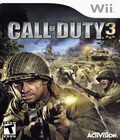Genre: WWII FPS
Publisher: Activision
Developer: Treyarch
Release Date: November 7, 2006
Prior to the release of the Xbox 360, I was working for a major video game retail chain that had (at the time) recently entered into a promotional contract with Dell. As such, Dell sent over a large display unit featuring a 42" plasma HD monitor and a top-of-the-line XPS desktop computer. Naturally, the first thing we did was hunt down some powerful games to show off to the customers (and play while on "break"). The first thing we nabbed was the demo for Call of Duty 2, which had just been released to the public. We were in awe – could a console replicate this experience? Would the Xbox 360 really be able to deliver this level of immersion?
Not only did the Xbox 360 version of Call of Duty 2 recreate those impressive visuals, but it did so at a higher level, eliminating the jaggies and pop-up associated with many PC games. Yet, when I got my launch system in late November, it wasn't the visual presentation that grabbed me. It was the surround sound. It was the intensity. It was the entire experience. Call of Duty 2 went on to be the top-selling game of the Xbox 360 launch, and picked up numerous accolades from the press (we named it the sixth best game of the year).
Talk about a tough act to follow! Unsurprisingly, a follow-up was in the works, releasing earlier this month as Call of Duty 3. However, series creators Infinity Ward were off the project, apparently working on something else (Call of Duty 4?). In stepped Treyarch, the studio responsible for the recent Spider-Man titles and Call of Duty 2: Big Red One, the spin-off sequel for the last-gen consoles. Also potentially troubling was the limited development schedule – would Call of Duty 3 mark a significant change or improvement over its predecessor, or would it be more of the same? Considering the quality of Call of Duty 2, would more of the same really be such a bad thing?
Like its predecessor, Call of Duty 3 puts you in the shoes of soldiers in several allied factions, with the American, British, Canadian, and Polish armies represented in this iteration. The narrative, set in 1944 during World War II, recounts the historic Normandy Breakout, a campaign that allowed the Allied troops to liberate Paris and push closer to Berlin. The American squad gets much more play than the others and seem to be in the picture for half of the game (or more), with the British taking up the other significant portion of the gameplay. Canada and Poland each see daylight in two missions – certainly not long enough for you to get to know the characters.
Even with the brief introductions, Call of Duty 3 lays it on thick with scripted story sequences – before, after, and during the 14 single-player missions. These scenes serve two main purposes; the first is to get you more involved with the experience of fighting a war. In an early scene, a truck in which you are riding is bombed, causing it to roll over. You wake up to find two men carrying you to safety, only to have one shot in the head. War is hell, eh? Other sequences exist to expand the skinny storylines, both internal (between members of the squad) and external (between Allied factions). The execution is a mixed bag; some dialogue feels dead-on and genuine, while other scenes just seem to perpetrate stereotypes.
As with its predecessor, one of the key elements of the Call of Duty experience is the extremely varied gameplay. Sure, it may be a first-person shooter, but the environments and situations are always different. For the basic shooting, you will have to get up close and personal, sneak around a bit, and do some sniping. At other times, you will have to command tanks, set bombs, and use your binoculars to call in air strikes. Call of Duty 3 adds a number of Jeep-driving sequences, which are surprisingly fun despite the less-than-preferable control scheme. As you weave your way along winding paths, through road blocks, and into fields, your follow soldiers will dispatch the enemy troops littering the countryside. It's a rush, and an unexpectedly positive addition to the already diverse selection of gameplay.
The biggest addition to the on-foot gameplay is the advent of close-quarters combat, which is represented by a handful of heavily scripted sequences. When it first happens, you may be impressed by the initial intensity of the scene, but the feeling doesn't last. When the enemy soldier pops out and grabs hold of your weapon, all you need to do is alternately pull the trigger buttons and hit whatever face buttons are displayed on the screen. It happens too often to be particularly thrilling, and is too simplistic to provide any kind of challenge.
Call of Duty 3's game engine also features an unfortunate amount of bugs and glitches, which manifest themselves on a regular basis. I sometimes found myself stuck between pieces of the environment and was taken out a couple of times by enemies as I struggled to right myself. At other times, I would find myself lodged between members of my squad and the enemy faction, eliminating the opportunity to escape to safety. Call of Duty 3 sometimes feels like it is lacking a final coat of polish, which is unfortunate, considering the rock-solid engine of its predecessor.
Another sticking point is the squad A.I., about which I have mixed feelings. When taking part in a large firefight, you can clearly see that your squadmates are taking out enemy soldiers. In fact, on the easier difficulties, you can take on the role of a bystander, occasionally popping out of cover to take down an enemy or two; your companions will take care of the rest. When it comes to infiltrating a house or a building, however, the A.I. cramps up, leaving you to take care of the majority of the carnage. You could storm into a room with five squad members and still single-handedly take out a half-dozen enemies. It can be sick to watch at times, and is something that must be addressed in future sequels.
The war-torn world of Call of Duty 3 is quite stunning, with destructible environments and endless heaps of rubble. Granted, an up-close view of said rubble reveals some iffy texturing, but a wide view of the landscape is still a sight to behold. Large blades of grass sway convincingly in the wind, and the smoke and lighting effects are still among the best in all of gaming. The character models are a different story altogether; they are still animated oddly and can occasionally be seen through walls and boxes. It's tough to consider them to be truly next-gen character models in the wake of the hyper-detailed Gears of War. Maybe I'm spoiled, or maybe I just expect more of an improvement after the additional year of development.
Call of Duty 3 ranks right at the top with its predecessor in terms of audio competence. No other game series has pushed my surround sound system to the max like Call of Duty, with whizzing bullets coming and going in all directions. The voice-over work is largely well done, though you may hear some of the same things over and over again, like "Nice shot! They ain't getting up!" The game also hits all the right notes with its fantastic score, which was composed by Joel Goldsmith (Stargate SG-1, Stargate: Atlantis). I'm glad to see that this is one area of the game that was left largely unchanged, as the riveting sound effects and original score significantly ratchet up the overall intensity of the experience.
Fans of online console shooters may want to consider checking out Call of Duty 3, especially after the underwhelming multiplayer options of the last game. Whereas Call of Duty 2 supported just eight players per game, Call of Duty 3 can take on 24 at a time and introduces a number of game types, including many that use a detailed class system. Battle is the standard free-for-all Deathmatch mode, while Team Battle brings classes into play for squad-based warfare. Capture the Flag is available in both standard and one-flag modes; the latter has both teams trying to bring the one flag to their base to score points. The War game type requires players to raise their flags on several areas of the map, while Headquarters challenges gamers to defend their bases for 90 seconds to earn a victory.
However, as with Call of Duty 2, the game has launched with several issues, the most significant being a flaw that locks out many router users from Ranked Matches. My cable modem doubles as a wired and wireless router, so I have no workaround, and I could only play the unranked Player Matches. It shocks me that such an issue would still be unresolved over two weeks after the game hit stores. If you use a router for your high-speed connection, beware: You may be unable to scale the leaderboards for some time. Based on what I played of the Player Matches, Call of Duty 3 is lag-free, intricate and exciting, and should prove to be one of the more popular online games – at least until Halo 3 comes out.
Call of Duty 3 may not be the impact title that its predecessor was, but it succeeds on its own as a strong expansion of an existing favorite. Other than a number of glitches and a currently unresolved online issue, the game delivers the same kind of intense experience that made the series a true next-gen contender. Some might dispute the titling of the game, considering the change of developer and lack of truly innovative gameplay, and I don't know that I could put up a strong argument to the contrary. However, though it may be remarkably similar to last year's model, Call of Duty 3 is a fine purchase for next-gen shooter fans.
Well, after you finish Gears of War.
Score: 8.6/10
More articles about Call of Duty 3











 Call of Duty 3 delivers the intensity of being closer than ever to the fury of combat during the battle for the Liberation of Paris, the most harrowing campaign of WWII, known as The Normandy Breakout. Through a seamless narrative, Call of Duty 3 delivers the rush of unrelenting battle and breathtaking action of the Allied offensive that changed the fate of the world.
Call of Duty 3 delivers the intensity of being closer than ever to the fury of combat during the battle for the Liberation of Paris, the most harrowing campaign of WWII, known as The Normandy Breakout. Through a seamless narrative, Call of Duty 3 delivers the rush of unrelenting battle and breathtaking action of the Allied offensive that changed the fate of the world.







































